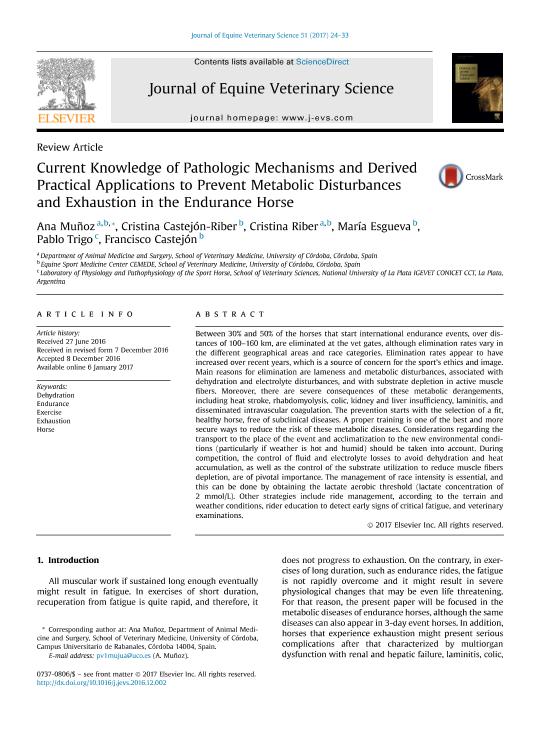Mostrar el registro sencillo del ítem
dc.contributor.author
Muñoz, Ana
dc.contributor.author
Castejón Riber, Cristina
dc.contributor.author
Riber, Cristina
dc.contributor.author
Esgueva, María
dc.contributor.author
Trigo, Pablo Ignacio

dc.contributor.author
Castejón, Francisco
dc.date.available
2018-06-11T20:31:03Z
dc.date.issued
2017-04
dc.identifier.citation
Muñoz, Ana; Castejón Riber, Cristina; Riber, Cristina; Esgueva, María; Trigo, Pablo Ignacio; et al.; Current Knowledge of Pathologic Mechanisms and Derived Practical Applications to Prevent Metabolic Disturbances and Exhaustion in the Endurance Horse; Elsevier Science Inc; Journal of Equine Veterinary Science; 51; 4-2017; 24-33
dc.identifier.issn
0737-0806
dc.identifier.uri
http://hdl.handle.net/11336/48170
dc.description.abstract
Between 30% and 50% of the horses that start international endurance events, over distances of 100–160 km, are eliminated at the vet gates, although elimination rates vary in the different geographical areas and race categories. Elimination rates appear to have increased over recent years, which is a source of concern for the sport´s ethics and image. Main reasons for elimination are lameness and metabolic disturbances, associated with dehydration and electrolyte disturbances, and with substrate depletion in active muscle fibers. Moreover, there are severe consequences of these metabolic derangements, including heat stroke, rhabdomyolysis, colic, kidney and liver insufficiency, laminitis, and disseminated intravascular coagulation. The prevention starts with the selection of a fit, healthy horse, free of subclinical diseases. A proper training is one of the best and more secure ways to reduce the risk of these metabolic diseases. Considerations regarding the transport to the place of the event and acclimatization to the new environmental conditions (particularly if weather is hot and humid) should be taken into account. During competition, the control of fluid and electrolyte losses to avoid dehydration and heat accumulation, as well as the control of the substrate utilization to reduce muscle fibers depletion, are of pivotal importance. The management of race intensity is essential, and this can be done by obtaining the lactate aerobic threshold (lactate concentration of 2 mmol/L). Other strategies include ride management, according to the terrain and weather conditions, rider education to detect early signs of critical fatigue, and veterinary examinations.
dc.format
application/pdf
dc.language.iso
eng
dc.publisher
Elsevier Science Inc

dc.rights
info:eu-repo/semantics/openAccess
dc.rights.uri
https://creativecommons.org/licenses/by-nc-sa/2.5/ar/
dc.subject
Dehydration
dc.subject
Endurance
dc.subject
Exercise
dc.subject
Exhaustion
dc.subject
Horse
dc.subject.classification
Otras Ciencias Veterinarias

dc.subject.classification
Ciencias Veterinarias

dc.subject.classification
CIENCIAS AGRÍCOLAS

dc.title
Current Knowledge of Pathologic Mechanisms and Derived Practical Applications to Prevent Metabolic Disturbances and Exhaustion in the Endurance Horse
dc.type
info:eu-repo/semantics/article
dc.type
info:ar-repo/semantics/artículo
dc.type
info:eu-repo/semantics/publishedVersion
dc.date.updated
2018-06-11T14:28:18Z
dc.journal.volume
51
dc.journal.pagination
24-33
dc.journal.pais
Estados Unidos

dc.journal.ciudad
Wildomar
dc.description.fil
Fil: Muñoz, Ana. Universidad de Córdoba; España
dc.description.fil
Fil: Castejón Riber, Cristina. Universidad de Córdoba; España
dc.description.fil
Fil: Riber, Cristina. Universidad de Córdoba; España
dc.description.fil
Fil: Esgueva, María. Universidad de Córdoba; España
dc.description.fil
Fil: Trigo, Pablo Ignacio. Consejo Nacional de Investigaciones Científicas y Técnicas. Centro Científico Tecnológico CONICET- La Plata. Instituto de Genética Veterinaria ; Argentina
dc.description.fil
Fil: Castejón, Francisco. Universidad de Córdoba; España
dc.journal.title
Journal of Equine Veterinary Science

dc.relation.alternativeid
info:eu-repo/semantics/altIdentifier/doi/https://dx.doi.org/10.1016/j.jevs.2016.12.002
dc.relation.alternativeid
info:eu-repo/semantics/altIdentifier/url/https://www.sciencedirect.com/science/article/pii/S073708061630380X
Archivos asociados
